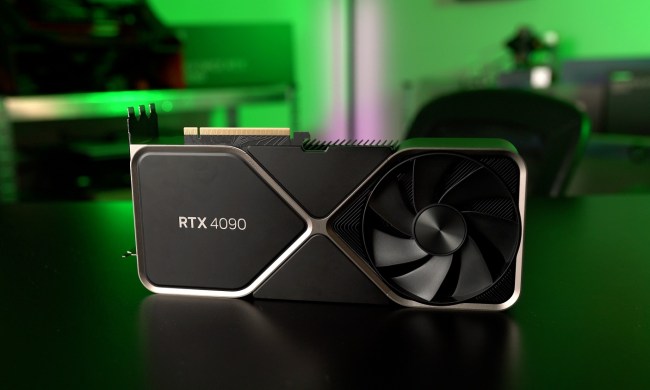Nvidia adds DLSS to six more games strengthening its lead in upscaling wars
Nvidia’s Deep Learning Super Sampling (DLSS) technology continues to expand rapidly with company bringing support to six additional games. The latest titles to incorporate DLSS features include Steel Seed, The Talos Principle: Reawakened, RuneScape: Dragonwilds, Tempest Rising, Clair Obscur:...

Digital Trends may earn a commission when you buy through links on our site. Why trust us?
 Nvidia
Nvidia
Nvidia’s Deep Learning Super Sampling (DLSS) technology continues to expand rapidly with company bringing support to six additional games. The latest titles to incorporate DLSS features include Steel Seed, The Talos Principle: Reawakened, RuneScape: Dragonwilds, Tempest Rising, Clair Obscur: Expedition 33, and Commandos: Origins.
Steel Seed, a stealth-action adventure title, now includes support for DLSS 4 Multi Frame Generation, offering notable performance gains for players using GeForce RTX 50-series GPUs. The Talos Principle: Reawakened, a modern take on the original puzzle game, has also added DLSS Frame Generation and Super Resolution, resulting in smoother frame rates and improved visual quality.
RuneScape: Dragonwilds and Tempest Rising have likewise adopted DLSS features, aiming to improve overall in-game performance. Meanwhile, upcoming releases Clair Obscur: Expedition 33 and Commandos: Origins are set to launch with DLSS Super Resolution, which should help boost frame rates and sharpen visuals across a wide range of RTX graphics cards.
Nvidia continues to dominate the upscaling landscape with DLSS now supported in over 760 games and applications, far ahead of AMD’s FSR and Intel’s XeSS. A key advantage is Nvidia’s ability to retrofit DLSS features into existing games using its Nvidia App. This manual override system allows engineers to enable technologies like Multi-Frame Generation even when developers haven’t officially implemented them, speeding up deployment across a broader range of titles.
In contrast, AMD’s FSR and Intel’s XeSS rely more heavily on developers to adopt newer versions like FSR 3.1 or XeSS 2.0, which has slowed progress. AMD’s newly introduced FSR 4 which was announced alongside the Radeon RX 9000-series, can upgrade some titles automatically, but support is still limited.
DLSS 4’s broad feature set and growing reach are helping cement Nvidia’s dominance in the GPU space. As more developers focus their efforts on DLSS, support for competing technologies may continue to lag. While AMD’s latest Radeon launch was well-received, matching Nvidia’s momentum in software support will take a lot more than just strong hardware.
Kunal Khullar is a computing writer at Digital Trends who contributes to various topics, including CPUs, GPUs, monitors, and…
DLSS 4 could be amazing, and Nvidia needs it to be
I won't lie: Nvidia did a good job with Deep Learning Super Sampling (DLSS) 3, and there's almost no way that this success didn't contribute to sales. DLSS 3, with its ability to turn a midrange GPU into something much more capable, is pretty groundbreaking, and that's a strong selling point if there ever was one.
What comes next, though? The RTX 40-series is almost at an end, and soon, there'll be new GPUs for Nvidia to try and sell -- potentially without the added incentive of gen-exclusive upscaling tech. DLSS 3 will be a tough act to follow, and if the rumors about its upcoming graphics cards turn out to be true, Nvidia may really need DLSS 4 to be a smash hit.
When the GPU barely matters
No more GPUs? Here’s what Nvidia’s DLSS 10 could look like
The latest version of Nvidia's Deep Learning Super Sampling (DLSS) is already a major selling point for some of its best graphics cards, but Nvidia has much bigger plans. According to Bryan Catanzaro, Nvidia's vice president of Applied Deep Learning Research, Nvidia imagines that DLSS 10 would have full neural rendering, bypassing the need for graphics cards to actually render a frame.
During a roundtable discussion hosted by Digital Foundry, Catanzaro delved deeper into what DLSS could evolve into in the future, and what kinds of problems machine learning might be able to tackle in games. We already have DLSS 3, which is capable of generating entire frames -- a huge step up from DLSS 2, which could only generate pixels. Now, Catanzaro said with confidence that the future of gaming lies in neural rendering.
Nvidia DLSS 3: explaining the AI-driven gaming tech
Nvidia's Deep Learning Super Sampling (DLSS) has been a staple of PC gaming for several years now, but DLSS 3 turns the tech on its head. It promises impossibly high frame rates in demanding games like Portal RTX by using AI to generate frames all on its own.
It's a simple concept, but DLSS 3 is complex. We're here to catch you up on what DLSS 3 is, how it works, and what games you'll find it in.
What is DLSS 3?

 JimMin
JimMin 















/cdn.vox-cdn.com/uploads/chorus_asset/file/25825790/Section31_JT_0205_05106_RT1copy.jpg)


















